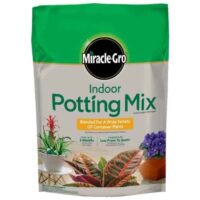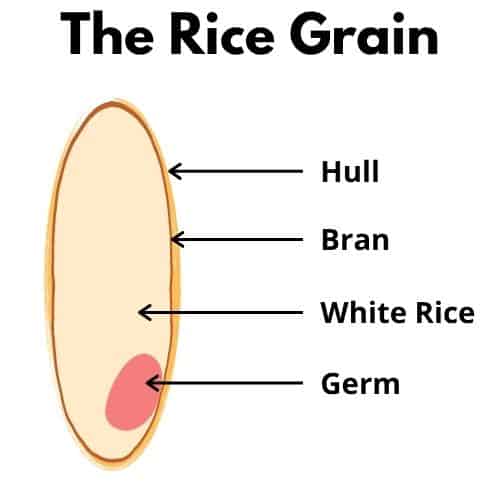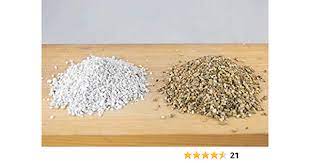How Does Instant Rice Help Your Garden
Adding rice is a good way to amend soil giving it good aeration and drainage properties. However, the right part of the rice grain must be used in order to effectively do so.
Rice hulls can provide a protective layer for topsoil when used as a mulch or mixed into the soil which prevents weeds and moisture loss in the garden. It also adds valuable nutrients to the soil when it is broken down by bacteria and microbes. A mixture of 20 to 50% hull provides the best results when used on potting soil.
In this article, we are going to go through the different parts of the rice grain and their benefits and shortcomings when used in the soil as well as how to add rice to the soil to increase drainage, aeration, and nutrients within the soil.
What are the Nutrients in Rice
Rice is a small edible seed that is cultivated from grain plants around the world. It nourishes billions of people each day and is a staple in many households.
This well-known staple is used mainly for its protein and carbohydrate content as it is used by the body to provide complex sugars for energy.
The nutrients in 60 grams of brown cooking rice are as follows –
| Nutrients | Brown Rice |
|---|---|
| energy | 82 calories |
| protein | 1.83 g |
| total lipid (fat) | 0.65 g |
| carbohydrates | 17.05 g |
| fiber, total dietary | 1.1 g |
| sugars, total | 0.16 g |
| calcium | 2 milligrams (mg) |
| iron | 0.37 mg |
| sodium | 3 mg |
| fatty acids, total saturated | 0.17 g |
Rice can also be used for plants. Adding the rice grains to the soil can give the soil beneficial properties from the start until it's completely broken down into the soil.
Additionally, from the above table, the organic compounds in the rice such as proteins and carbohydrates, when broken down can add vital nitrogen to the soil.
However, if you need a good potting mix that comes with its own soil amendment, we recommend miracle gro indoor potting mix which ensures your plant survives long after repotting.

Pro Tip –
The right part of the rice grain (The Hull) should be used when adding to soil to prevent dehydrating the plant.
Rice (the white part) is widely known for its desiccant properties as it is commonly used as a quick fix to remove water from a phone's circuitry after it has fallen in water.
A desiccant is a hygroscopic substance that is used to induce or sustain a state of dryness (desiccation) in its vicinity; it is the opposite of a humectant. Commonly encountered pre-packaged desiccants are solids that absorb water. (Source)
From the definition above, adding rice gains to the soil it can significantly reduce the moisture content within the soil causing the plant to also become dehydrated and stressed.
Parts of the Rice Grain

The Hull
Each grain of rice is enclosed in a tough outer hull, or husk, that needs to be removed before it can be consumed.
Rice hulls are the husks that are removed from each grain of rice after harvest. The hulls are then parboiled at a high enough heat to sterilize.
This hull is the most beneficial to plants, especially when used as a mulch.
The Bran
Under the hull, the bran layer is not removed in all rice types. This nutritious whole grain section is usually tan-colored, but it may be reddish or black depending on the pigmentation in the bran layers.
White Rice
Once the bran and germ layers are removed, white rice remains. Known as the endosperm, this is the part of the rice that is most commonly consumed.
Although some people use this part of the rice grain as a soil amendment, it is not recommended and can have some negative effects on the soil which we explain later on.
The Germ
Found under the hull, the germ, or rice kernel, is nutrient-dense. Full of B vitamins, minerals, and proteins, it helps give rice its color and added nutritional benefits.
The Benefits of Using Rice in the Soil
Rice hulls, (not the rice grains), are one of the most sustainable soil amendments available for improving drainage, water holding capacity and aeration.
When compared to other soil amendments like perlite, vermiculite, and peat moss, rice hulls are the most sustainable when it comes to production.
Since it is the byproduct of a very widely used commodity (rice) it can safely be used as a replacement for many other mined amendments.

Better Drainage
Rice can be used as a soil amendment for drainage. The rice grains help create gaps in more dense soils providing a passage for water to run and drain free out of the soil.
This can help to prevent problems such as root rot which can be caused by waterlogged soil or various kinds of fungi.
On the other hand, the rice hulls also have good water retention ability whereby the right amount of water is retained within the soil which is enough to feed the plant.
Better Aeration
Along with good drainage, the spaces created by the rice hull within the soil provide oxygen to the roots of the plant which is then used for biological processes such as photosynthesis.
Although rice hulls may not be as effective as their mined counterparts, perlite and vermiculite when it comes to aeration it is a very sustainable and energy-efficient source as a soil amendment.
Helps Neutralize the Soil's pH
Rice hulls are neutral in pH which sits at 7.0 pH. It can be used in a 50/50 soil to hull mixture to help balance out and reduce the effects of acidity and alkalinity in soil.
Acidic soil can range from5.0 to 7.0 pH, where the 6.5 closer to the 7.0 mark is the weakest acid range.
Alkaline Soils can range from 7.0 to 10 in the pH range, where closer to the 7.0 mark is the weakest alkaline range.
Acidic and alkaline soil can cause serious harm to plants as the extreme deviation in pH can render nutrients within the soil useless to the plant.
This leads to a number of plant deficiencies which can lead to the death of the plant.
Adds Nutrients from the Hull
When broken down the nutrients from the hull are added directly into the soil for the plants to use.
Rice is an organic compound containing a great deal of nitrogen and carbon compounds and when broken down by the bacteria in the soil it releases these nutrients for the plant to use.
Nitrogen is so vital because it is a major component of chlorophyll, the compound by which plants use sunlight energy to produce sugars from water and carbon dioxide in photosynthesis.
You can find a cost-effective mix of perlite and vermiculite for all your potting needs on Amazon. Find it by clicking here.

What are the Downsides of Adding Rice Grains to Soil

If you are going to use rice grains rather than just the hulls in the soil here are a few things you should keep in mind when going this route.
Absorbs Water
The rice grains can absorb water from the soil and swell. This is because the grains will act as a desiccant and absorb water. As the water is absorbed it will begin to swell and grow bigger.
This can lead to soil compaction and bad drainage not to mention that the rice will rob the surrounding moisture from the soil itself.
This in turn will dehydrate the plant and cause it to wilt.
Produces a Bad Smell
Rice grains contain between 1.5 to 2 grams of proteins per 60 grams of rice. The proteins from the rice, through watering, will eventually be broken down by bacteria in the soil.
Protein synthesis releases smelly gases such as hydrogen sulfide (H2S).
The odor can leave your house and surrounding areas with a very unattractive scent.
Can Cause a Nitrogen Deficiency
The breakdown process of organic compounds can lead to a temporary Nitrogen deficiency in the soil.
Nitrogen deficiency in plants can occur when organic matter with high carbon content, such as sawdust, is added to soil. Soil organisms use any nitrogen to break down carbon sources, making Nitrogen unavailable to plants. [Source]
A shortage of nitrogen results in a marked decrease in plant photosynthesis and nitrogen allocation to the leaves in many plants.
Reduced nitrogen will therefore lead to pale yellow-green color leaves and also slow or stunted growth of the plant.
Attracts Unwanted Pets
Rice can attract unwanted attention to your plants. The smell of the rice when it absorbs water can be similar to when it is being cooked.
This can attract pets and other wild animals, especially ants to your plant.
The soil can be ingested by pets in search of food which can lead to serious health problems not to mention the mess the pets would create while foraging through the soil.
We have written a detailed article on how potting soil will affect dogs if ingested. You can see it here.
It can Sprout Rice Shoots
If you Use the wrong rice grain, it can sprout into a rice plant. Rice is essentially a seed. What we have discussed in this article is the benefits of using the Hull from the rice grain.
When the whole rice grain together with the husk intact, it can sprout into new rice plants.
What happens when this occurs is that the new shoots will rob the main plant of nutrients as they use nutrients from the soil to grow.
The new rice shoots are now considered a weed rather than a plant.
Rice Hulls Vs Rice Grains
| Rice Hulls | Rice grains |
|---|---|
| Can be used as a mulch | Can be used as a mulch but absorbs moisture from the soil |
| Can be mixed in 2 to 4 inches into the soil | Should be Mixed deeper into the soil |
| Don't produce any foul smells when being broken down | Produces smelly odors as it is being broken down |
| Takes little or no nitrogen from the soil | Can temporarily cause a nitrogen deficiency as bacteria use it to decompose the rice |
| Does not produce sprouts | Sprouts can shoot up which can produce similar effects of weeds in the soil |
| Does not attract attracts pets and animals to the soil | Attracts unwanted attention from pets to the soil |
How to Add Rice to the Soil
Do not add cooked rice to the soil.
Using the Rice Grains
If you do decide to use dry rice grains, you should mix the grains 2 to 4 inches into the top layer of the soil to ensure that it is completely covered and hidden.
Using Rice Husk or Rice Hull
For potted plants, you should mix 20 to 50% of the rice hulls into your potting soil as an amendment before planting.
Additionally, the rice hulls can be used as a mulch which over time will break down and add vital nutrients to the soil, after which it can be topped up.
Using rice hull in the garden as mulch can be very light and will be blown away by the wind easily. It is recommended that it be covered by an additional layer of mulch such as wood chips or stones.
Precautions to take if Using Rice Grains
Use mulch after addition
As previously stated, the rice can attract unwanted attention.
Covering the topsoil with stones can be beneficial when it comes to protecting the soil and your plant from pets.
This serves as a barrier to curious pets that may cause unwanted harm to themselves and the plant.
Use Sparingly
When using rice grain in the soil don't go with a 20 – 50% mix as described with the rice hulls.
Instead, use a 10 to 15% mixture of rice grain to soil to prevent the drawbacks of having too much rice in the soil.
Can Rice be Used as a Potting Medium?
Rice can be used as a potting medium for plants that have a low tolerance for water. Succulents, Air plants, and Lavender are ideal for growing in an all rice potting medium as they only require small quantities of water to survive.
Caution must be taken when using rice as a potting medium. Although it is said that it will have great drainage and aeration properties the rice can easily soak water and start to rot.
What we do recommend, when using rice as a potting medium is that the watering is kept to only misting, especially for succulents.
Misting allows for only a fine mist of water to be sprayed onto the leaves of the plant. The plant absorbs the water it needs through the stomata, fund on the underside of the leaves.
Misting would prevent the rice from absorbing too much water and rotting.
You can see our detailed article on how to correctly mist plants to get the best results when using rice as a potting medium.
Will Rice Water Benefit the Soil?
Rice water is a byproduct of washing the rice before it is cooked. As the rice is washed, the grains will release fine rice dust from the processing activity.
This gives the water some of the nutrient characteristics of the rice which can be used as a substitute for conventional fertilizers, on plants.
Rice water is a mild fertilizer and can be used consistently which would limit the use or inorganic fertilizers.
The starches from leftover rice water will help encourage beneficial microbial and bacterial activity in the soil, which will add nitrogen to the soil from the breakdown of proteins and minerals within the rice water.
See our detailed article on how rice water can benefit plants.
The Takeaway
Rice can be used on the soil both as a mulch and as an amendment.
Rice is essentially a seed and the rice pod has different parts which can be used on soil.
However, certain precautions must be taken if you are using the white grains rather than the hull by itself.
If applied the wrong way the rice grains can produce shoots or even rob the soil of nitrogen which can directly affect the plants.
The hulls are most beneficial when used on both potting and garden soil as a mulch and as an amendment.
How Does Instant Rice Help Your Garden
Source: https://flourishingplants.com/how-to-correctly-use-rice-on-soil/
Posted by: boozeyoring40.blogspot.com

0 Response to "How Does Instant Rice Help Your Garden"
Post a Comment